Sanaa Sharafeddine
Meta-Learning-Driven Resource Optimization in Full-Duplex ISAC with Movable Antennas
Oct 01, 2025Abstract:This paper investigates a full-duplex (FD) scenario where a base station (BS) equipped with movable antennas (MAs) simultaneously provides communication services to a set of downlink (DL) and uplink (UL) users while also enabling sensing functionalities for target detection, thereby supporting integrated sensing and communication (ISAC) technology. Additionally, a receiving BS, also equipped with MAs (denoted as BS R), is responsible for capturing the reflected echo. To optimize this setup, we formulate an optimization problem aimed at maximizing the signal-to-noise and interference ratio (SINR) of the captured echo. This is achieved by jointly optimizing the transmit beamforming vectors at the FD BS, the receiving beamforming vectors at both the FD BS and BS R, the UL users' transmit power, and the MAs' positions at both BSs, all while satisfying the quality-of-service (QoS) requirements for both sensing and communication. Given the non-convex nature of the problem and the high coupling between the variables, we employ a gradient-based meta-learning (GML) approach tailored for large-scale optimization. Numerical results demonstrate the effectiveness of the proposed meta-learning approach, achieving results within 99% of the optimal solution. Furthermore, the MA-based scheme outperforms several benchmark approaches, highlighting its advantages in practical ISAC applications.
A UAV-Aided Digital Twin Framework for IoT Networks with High Accuracy and Synchronization
Apr 22, 2025Abstract:With the continued growth of its core technologies, including the Internet of Things (IoT), artificial intelligence (AI), Big Data and data analytics, and edge computing, digital twin (DT) technology has witnessed a significant increase in industrial applications, helping the industry become more sustainable, smart, and adaptable. Hence, DT technology has emerged as a promising link between the physical and virtual worlds, enabling simulation, prediction, and real-time performance optimization. This work aims to explore the development of a high-fidelity digital twin framework, focusing on synchronization and accuracy between physical and digital systems to enhance data-driven decision making. To achieve this, we deploy several stationary UAVs in optimized locations to collect data from industrial IoT devices, which were used to monitor multiple physical entities and perform computations to evaluate their status. We consider a practical setup in which multiple IoT devices may monitor a single physical entity, and as a result, the measurements are combined and processed together to determine the status of the physical entity. The resulting status updates are subsequently uploaded from the UAVs to the base station, where the DT resides. In this work, we consider a novel metric based on the Age of Information (AoI), coined as the Age of Digital Twin (AoDT), to reflect the status freshness of the digital twin. Factoring AoDT in the problem formulation ensures that the DT reliably mirrors the physical system with high accuracy and synchronization. We formulate a mixed-integer non-convex program to maximize the total amount of data collected from all IoT devices while ensuring a constrained AoDT. Using successive convex approximations, we solve the problem, conduct extensive simulations and compare the results with baseline approaches to demonstrate the effectiveness of the proposed solution.
Meta-Learning Driven Movable-Antenna-assisted Full-Duplex RSMA for Multi-User Communication: Performance and Optimization
Apr 04, 2025Abstract:Full-duplex (FD) radios at base station (BS) have gained significant interest because of their ability to simultaneously transmit and receive signals on the same frequency band. However, FD communication is hindered by self-interference (SI) and intra-cell interference caused by simultaneous uplink (UL) transmissions affecting downlink (DL) reception. These interferences significantly limit the ability to fully exploit FD's potential. Recently, movable antenna (MA) technology has emerged as a groundbreaking innovation, offering an effective way to mitigate interference by adjusting the position of each MA within the transmitter or receiver region. This dynamic repositioning allows MAs to move away from high-interference zones to areas with minimal interference, thereby enhancing multiplexing gain and improving spectral efficiency (SE). In light of this, in this paper, we investigate an FD communication system by integrating it with MAs to evaluate and investigate its effectiveness in handling SI and intra-cell interference. Moreover, we utilize rate-splitting multiple access (RSMA) as our multiple access technique in both UL and DL transmission. To achieve the full potential of the system, we evaluated three different scenarios with FD-BS-RSMA with MAs where our goal is to maximize the total sum rate of the system by jointly optimizing the transmitting and receiving beamforming vectors, UL user equipment (UE) transmission power, MA positions, and common stream split ratio of RSMA while satisfying the minimum data rate requirements of all UEs, common stream constraint, power budget requirements of BS and UL UEs, and inter-MA distance. The formulated optimization problem is highly non-convex in nature, and hence, we propose a gradient-based meta-learning (GML) approach which can handle the non-convexity in a discrete manner by optimizing each variable in a different neural network.
Enhancing CoMP-RSMA Performance with Movable Antennas: A Meta-Learning Optimization Framework
Feb 24, 2025Abstract:This study investigates a downlink rate-splitting multiple access (RSMA) scenario in which multiple base stations (BSs), employing a coordinated multi-point (CoMP) transmission scheme, serve users equipped with movable antenna (MA) technology. Unlike traditional fixed-position antennas (FPAs), which are subject to random variations in wireless channels, MAs can be strategically repositioned to locations with more favorable channel conditions, thereby achieving enhanced spatial diversity gains.To leverage these advantages and maximize the achievable sum rate, we formulate an optimization problem that jointly determines the optimal transmit beamforming vectors at the BSs, the common stream allocation for different users, and the optimal positioning of the MAs, all while ensuring compliance with quality of service (QoS) constraints. However, the formulated problem is non-convex and computationally challenging due to the strong interdependence among the optimization variables. Traditional methods for solving large-scale optimization problems typically incur prohibitively high computational complexity. To address the above challenge, we propose a gradient-based meta-learning (GML) algorithm that operates without pre-training and is well-suited for handling large-scale optimization tasks. Numerical results demonstrate the effectiveness and accuracy of the proposed approach, achieving near-optimal performance (exceeding 97% compared to the optimal solution). Moreover, the MA-enabled CoMP-RSMA model significantly outperforms conventional benchmark schemes, yielding performance gains of up to 190% over the spatial division multiple access (SDMA) scheme and 80% over the RSMA FPA-based model. Finally, the proposed approach is shown to mitigate the sum-rate limitations imposed by interference in SDMA, achieving superior performance with fewer BSs.
Gradient-Based Meta Learning for Uplink RSMA with Beyond Diagonal RIS
Oct 23, 2024



Abstract:Beyond diagonal reconfigurable intelligent surface (BD-RIS) has emerged as an innovative and generalized RIS framework that provides greater flexibility in wave manipulation and enhanced coverage. In comparison to conventional RIS, optimization of BD-RIS is more challenging due to the large number of optimization variables associated with it. Typically, optimization of large-scale optimization problems utilizing traditional optimization methods results in high complexity. To tackle this issue, we propose a gradient-based meta learning algorithm which works without pre-training and is able to solve large-scale optimization problems. With the objective to maximize the sum rate of the system, to the best of our knowledge, this is the first work considering joint optimization of receiving beamforming vectors at the base station (BS), scattering matrix of BD-RIS and transmission power of users equipment (UEs) in uplink rate-splitting multiple access (RSMA) communication. Numerical results demonstrate that our proposed scheme can outperform the conventional RIS RSMA framework by 22.5$\%$.
Optimizing Multi-User Uplink Cooperative Rate-Splitting Multiple Access: Efficient User Pairing and Resource Allocation
Sep 03, 2024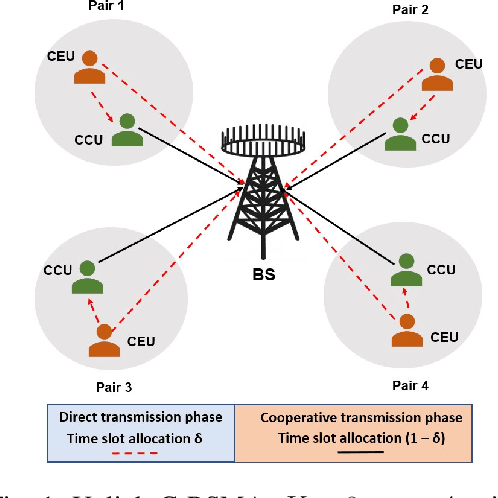
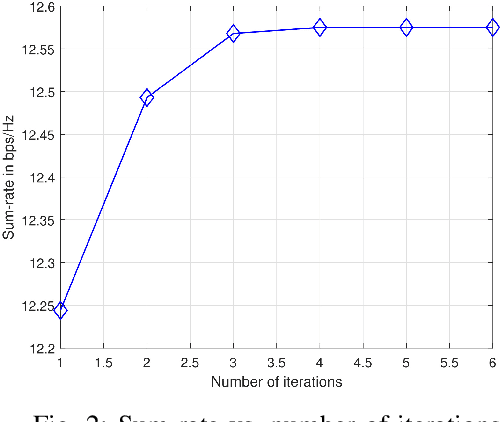
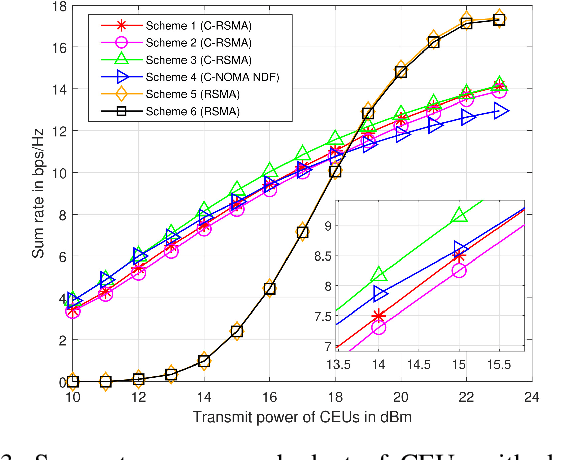
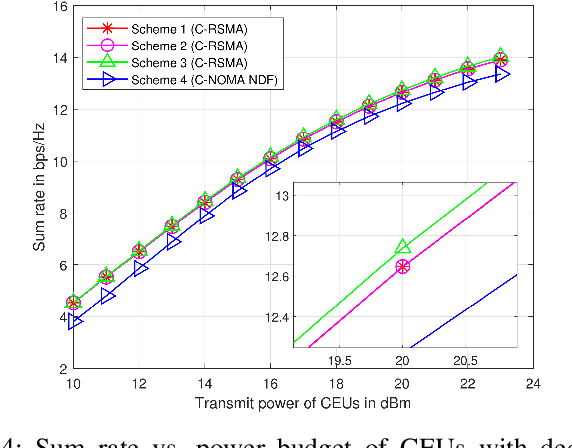
Abstract:This paper investigates joint user pairing, power and time slot duration allocation in the uplink multiple-input single-output (MISO) multi-user cooperative rate-splitting multiple access (C-RSMA) networks in half-duplex (HD) mode. We assume two types of users: cell-center users (CCU) and cell-edge users (CEU); first, we propose a user pairing scheme utilizing a semi-orthogonal user selection (SUS) and a matching-game (MG)-based approach where the SUS algorithm is used to select CCU in each pair which assists in reducing inter-pair interference (IPI). Afterward, the CEU in each pair is selected by considering the highest channel gain between CCU and CEU. After pairing is performed, the communication takes place in two phases: in the first phase, in a given pair, CEUs broadcast their signal, which is received by the base station (BS) and CCUs. In the second phase, in a given pair, the CCU decodes the signal from its paired CEU, superimposes its own signal, and transmits it to the BS. We formulate a joint optimization problem in order to maximize the sum rate subject to the constraints of the power budget of the user equipment (UE) and Quality of Service (QoS) requirements at each UE. Since the formulated optimization problem is non-convex, we adopt a bi-level optimization to make the problem tractable. We decompose the original problem into two sub-problems: the user pairing sub-problem and the resource allocation sub-problem where user pairing sub-problem is independent of resource allocation sub-problem and once pairs are identified, resource allocation sub-problem is solved for a given pair. Resource allocation sub-problem is solved by invoking a successive convex approximation (SCA)-based approach. Simulation results demonstrate that the proposed SUS-MG-based algorithm with SCA outperforms other conventional schemes.
Multi-IRS Aided Mobile Edge Computing for High Reliability and Low Latency Services
Dec 14, 2023



Abstract:Although multi-access edge computing (MEC) has allowed for computation offloading at the network edge, weak wireless signals in the radio access network caused by obstacles and high network load are still preventing efficient edge computation offloading, especially for user requests with stringent latency and reliability requirements. Intelligent reflective surfaces (IRS) have recently emerged as a technology capable of enhancing the quality of the signals in the radio access network, where passive reflecting elements can be tuned to improve the uplink or downlink signals. Harnessing the IRS's potential in enhancing the performance of edge computation offloading, in this paper, we study the optimized use of a system of multi-IRS along with the design of the offloading (to an edge with multi MECs) and resource allocation parameters for the purpose of minimizing the devices' energy consumption considering 5G services with stringent latency and reliability requirements. After presenting our non-convex mathematical problem, we propose a suboptimal solution based on alternating optimization where we divide the problem into sub-problems which are then solved separately. Specifically, the offloading decision is solved through a matching game algorithm, and then the IRS phase shifts and resource allocation optimizations are solved in an alternating fashion using the Difference of Convex approach. The obtained results demonstrate the gains both in energy and network resources and highlight the IRS's influence on the design of the MEC parameters.
Energy Consumption Optimization in RIS-Assisted Cooperative RSMA Cellular Networks
Aug 13, 2022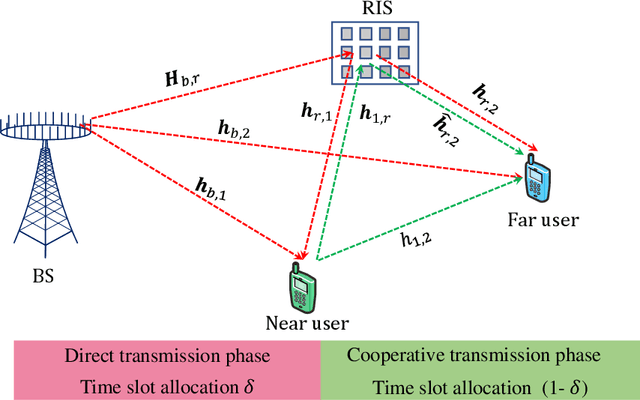
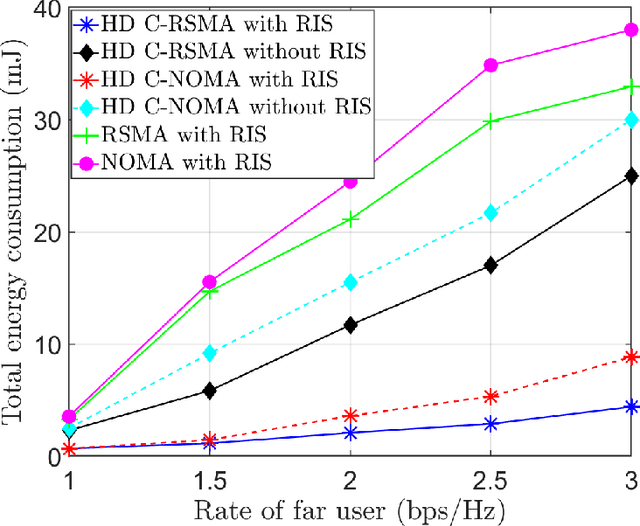
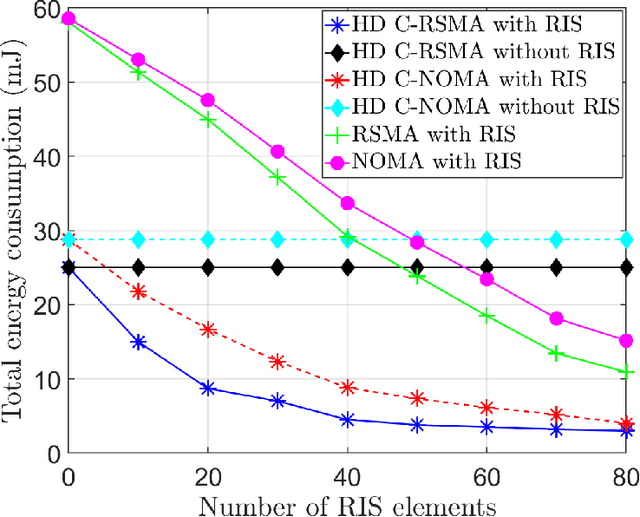
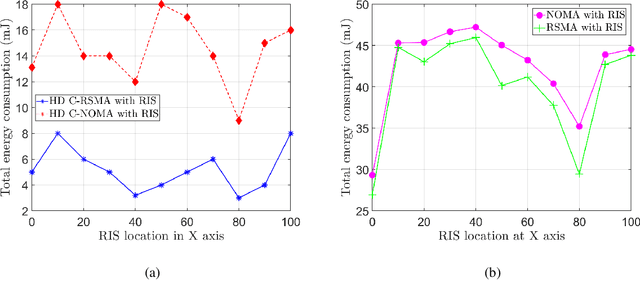
Abstract:This paper presents a downlink reconfigurable intelligent surface (RIS)-assisted half-duplex (HD) cooperative rate splitting multiple access (C-RSMA) networks. The proposed system model is built up considering one base station (BS), one RIS, and two users. With the goal of minimizing the network energy consumption, a joint framework to optimize the precoding vectors at the BS, common stream split, relaying device transmit power, the time slot allocation, and the passive beamforming at the RIS subject to the power budget constraints at both the BS and the relaying node, the quality of service (QoS) constraints at both users, and common stream rate constraint is proposed. The formulated problem is a non-convex optimization problem due to the high coupling among the optimization variables. To tackle this challenge, an efficient algorithm is presented by invoking the alternating optimization technique, which decomposes the original problem into two sub-problems; namely, sub-problem-1 and sub-problem-2, which are alternatively solved. Specifically, sub-problem-1 is to jointly optimize the precoding vectors, common stream split, and relaying device power. Meanwhile, sub-problem-2 is to optimize the phase shift matrix at the RIS. In order to solve sub-problem-1, an efficient low-complexity solution based on the successive convex approximation (SCA) is proposed. Meanwhile, and with the aid of difference-of-convex rank-one representation and the SCA approach, an efficient solution for the phase shift matrix at the RIS is obtained. The simulation results demonstrate that the proposed RIS-assisted HD C-RSMA achieves a significant gain in minimizing the total energy consumption compared to the RIS-assisted RSMA scheme, RIS-assisted HD cooperative non-orthogonal multiple access (C-NOMA), RIS-assisted NOMA, HD C-RSMA without RIS, and HD C-NOMA without RIS.
RIS-Assisted UAV for Timely Data Collection in IoT Networks
Mar 31, 2021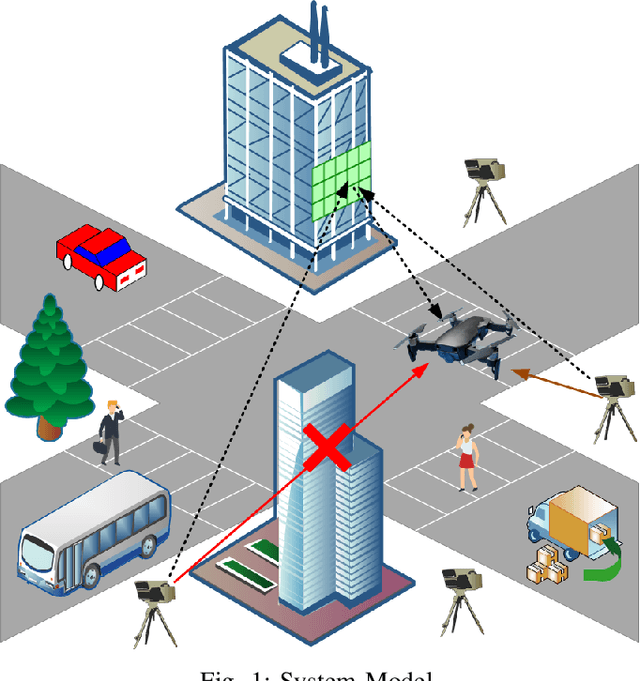
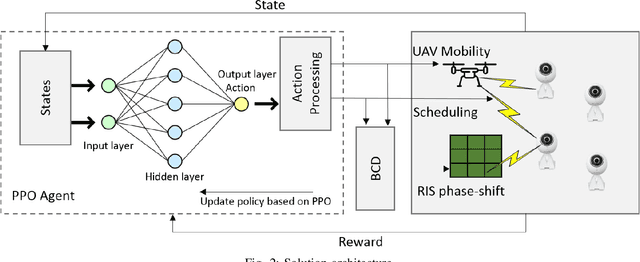
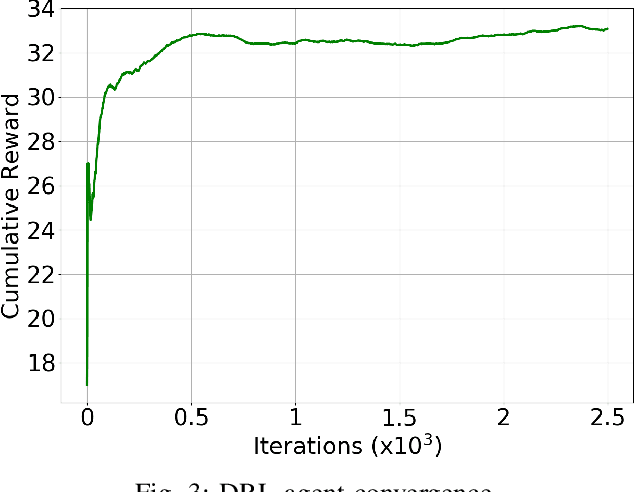
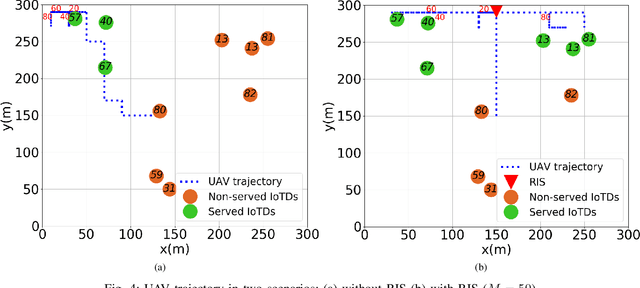
Abstract:Smart city services are thriving thanks to a wide range of technological advances, namely 5G communications, Internet of Things (IoT), and artificial intelligence. Central to this is the wide deployment of smart sensing devices and accordingly the large amount of harvested information to be processed for timely decision making. Robust network access is, hence, essential for offloading the collected data before a set deadline, beyond which the data loses its value. In environments where direct communication can be impaired by blockages, unmanned aerial vehicles (UAVs) can be considered as an alternative for enhancing connectivity, particularly when IoT devices (IoTDs) are constrained with their resources. Moreover, to conserve energy, IoTDs are assumed to alternate between their active and passive modes. This paper, therefore, considers a time-constrained data gathering problem from a network of sensing devices and with assistance from a UAV. A reconfigurable intelligent surface (RIS) is deployed to further improve the connectivity to the UAV, particularly when the multiple devices are served concurrently and experience different channel impairments. This integrated problem brings challenges related to the configuration of the phase shift elements of the RIS, the scheduling of IoTDs transmissions, and the trajectory of the UAV. First, the problem is formulated with the objective of maximizing the total number of served IoTDs each during its activation period. Owing to its complexity and the incomplete knowledge about the environment, we leverage deep reinforcement learning in our solution; the UAV trajectory planning is modeled as a Markov Decision Process, and Proximal Policy Optimization is invoked to solve it. Next, the RIS configuration is then handled via Block Coordinate Descent. Finally, extensive simulations are conducted to demonstrate the efficiency of our solution approach.
Reconfigurable Intelligent Surface Enabled Vehicular Communication: Joint User Scheduling and Passive Beamforming
Jan 28, 2021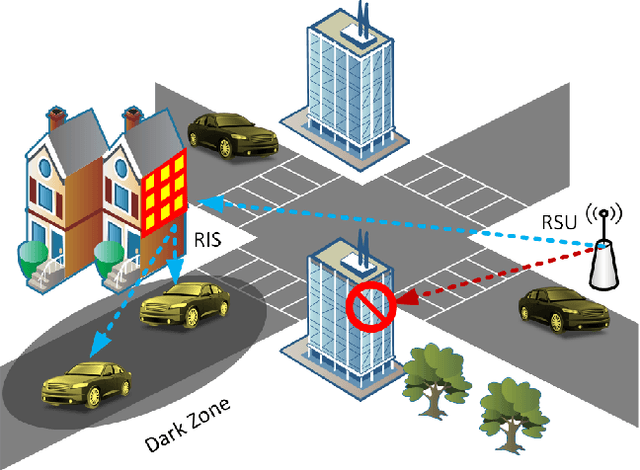
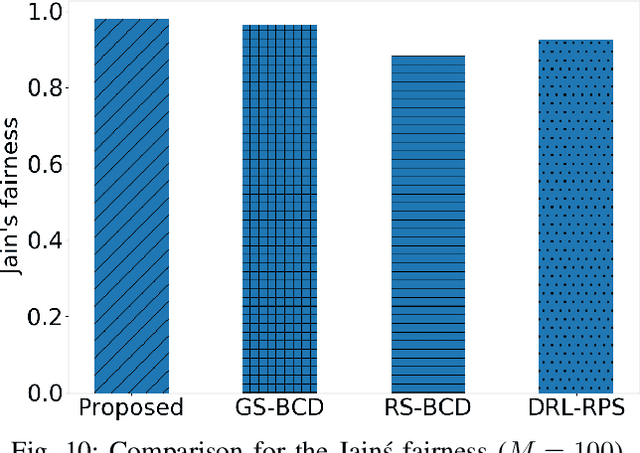
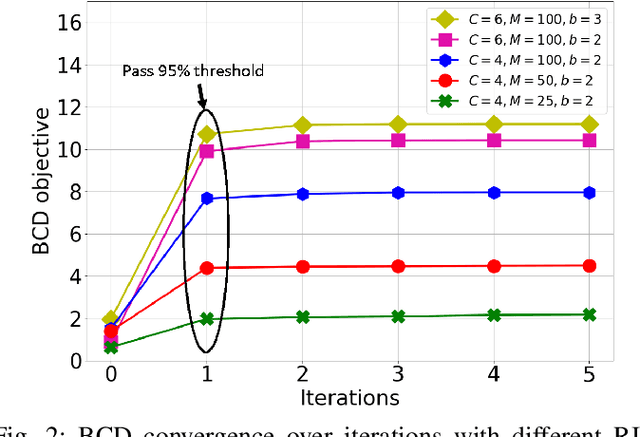
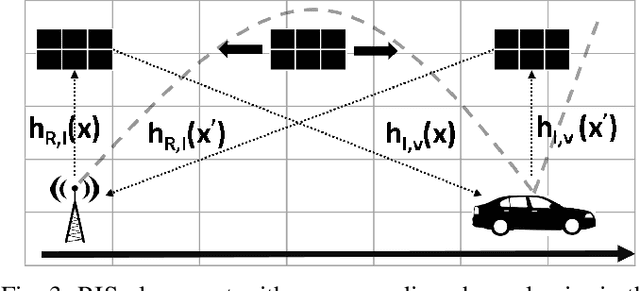
Abstract:Given its ability to control and manipulate wireless environments, reconfigurable intelligent surface (RIS), also known as intelligent reflecting surface (IRS), has emerged as a key enabler technology for the six-generation (6G) cellular networks. In the meantime, vehicular environment radio propagation is negatively influenced by a large set of objects that cause transmission distortion such as high buildings. Therefore, this work is devoted to explore the area of RIS technology integration with vehicular communications while considering the dynamic nature of such communication environment. Specifically, we provide a system model where RoadSide Unit (RSU) leverages RIS to provide indirect wireless transmissions to disconnected areas, known as dark zones. Dark zones are spots within RSU coverage where the communication links are blocked due to the existence of blockages. In details, a discrete RIS is utilized to provide communication links between the RSU and the vehicles passing through out-of-service zones. Therefore, the joint problem of RSU resource scheduling and RIS passive beamforming or phase-shift matrix is formulated as an optimization problem with the objective of maximizing the minimum average bit rate. The formulated problem is mixed integer non-convex program which is difficult to be solved and does not account for the uncertain dynamic environment in vehicular networks. Thereby, we resort to alternative methods based on Deep Reinforcement Learning to determine RSU wireless scheduling and Block Coordinate Descent (BCD) to solve for the phase-shift matrix, \textit{i.e.,} passive beamforming, of the RIS. The Markov Decision Process (MDP) is defined and the complexity of the solution approach is discussed. Our numerical results demonstrate the superiority of our proposed approach over baseline techniques.
 Add to Chrome
Add to Chrome Add to Firefox
Add to Firefox Add to Edge
Add to Edge